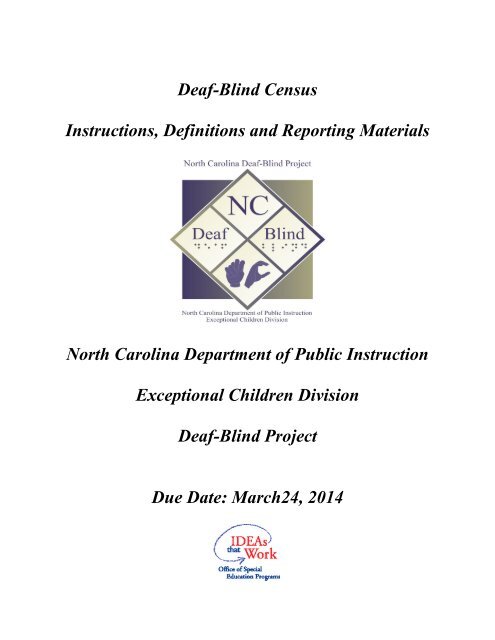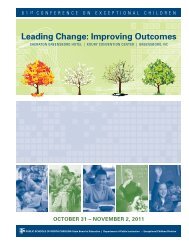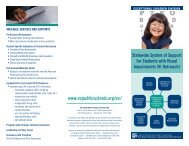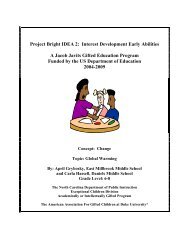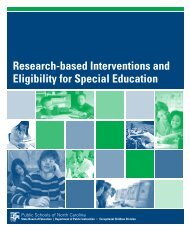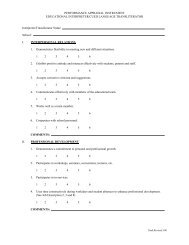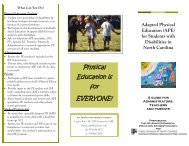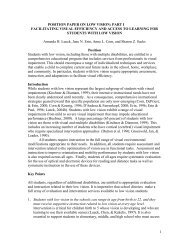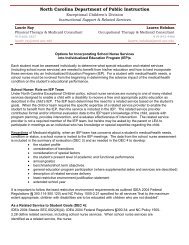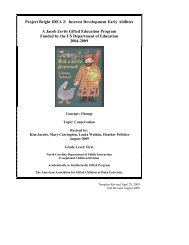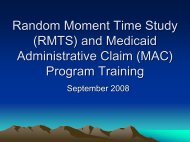Deaf-Blind Child Census - Exceptional Children
Deaf-Blind Child Census - Exceptional Children
Deaf-Blind Child Census - Exceptional Children
You also want an ePaper? Increase the reach of your titles
YUMPU automatically turns print PDFs into web optimized ePapers that Google loves.
<strong>Deaf</strong>-<strong>Blind</strong> <strong>Census</strong>Instructions, Definitions and Reporting MaterialsNorth Carolina Department of Public Instruction<strong>Exceptional</strong> <strong>Child</strong>ren Division<strong>Deaf</strong>-<strong>Blind</strong> ProjectDue Date: March24, 2014
Survey Page 1 DirectionsIndicate whether or not the child has been included on the census in the past.Has this child been reported on the census prior to the 2013 submission?• Yes• NoSurvey Page 2 DirectionsName of person completing the surveyPlease give first and last nameContact person’s phone numberGive a number where you can be reached for verification of dataLEA CodeIf the child is enrolled in an LEA program please give the LEA Code<strong>Child</strong> ID CodeUsing uppercase letters, indicate the first 2 characters of the first name and the first 2 charactersof the last name of the individual to create a 4 digit alpha-character code. Duplications in thisfield are permissible. For names that are hyphenated, please use the first 2 characters of thebeginning name of the hyphenated name. For example, John Doe-Rey would be coded as JODO.NCWISE IDEnter the child’s NC WISE number. If this number has not been assigned, enter 201300.First NameEnter the child’s first name. Do not use nicknames.Last nameEnter the child’s last name (middle initials and middle names are not needed).Date of BirthEnter the month, day and year of birth (mm/dd/yyyy)GenderIndicate the individual’s gender by coding as:0. Male1. FemaleStudents Home AddressCityStateZip CodeEnter the child’s Parent/Guardian residence; street address or Po Box, City, State and Zip Code3
School NameIf child is enrolled in an LEA, enter the school name where child is in attendance.Teacher’s NameEnter the First and last name of the student’s current teacher.Teacher’s E-mailEnter the e-mail address of the student’s current teacher.Student GradeEnter the grade in which the student is enrolled.Parent/GuardianEnter the first and last name of the child’s Parent/GuardianParent/Guardian PhoneEnter the phone number of the child’s Parent/Guardian or if the family does not have a numberenter NA.Parent/Guardian E-mailEnter the e-mail address of the child’s Parent/Guardian or if the family does not have e-mailenter NA.Survey Page 3 DirectionsEtiologySelect the one etiology code from the list that best describes the primary etiology of theindividual’s primary disability.If “other “(e.g., 199, 299 or 399) is selected, please specify the etiology in the space provided.Column 8 - Primary Identified Etiology101 Aicardi syndrome102 Alport syndrome103 Alstrom syndrome104 Apert syndrome (Acrocephalosyndactyly, Type 1)105 Bardet-Biedl syndrome (Laurence Moon-Biedl)106 Batten disease107 CHARGE association108 Chromosome 18, Ring 18109 Cockayne syndrome110 Cogan Syndrome111 Cornelia de Lange112 Cri du chat syndrome (Chromosome 5p- syndrome)113 Crigler-Najjar syndrome114 Crouzon syndrome (Craniofacial Dysotosis)115 Dandy Walker syndrome116 Down syndrome (Trisomy 21 syndrome)117 Goldenhar syndrome118 Hand-Schuller-Christian (Histiocytosis X)119 Hallgren syndrome120 Herpes-Zoster (or Hunt)121 Hunter Syndrome (MPS II)Hereditary/Chromosomal Syndromes and Disorders130 Marshall syndrome131 Maroteaux-Lamy syndrome (MPS VI)132 Moebius syndrome133 Monosomy 10p134 Morquio syndrome (MPS IV-B)135 NF1 - Neurofibromatosis (von Recklinghausen disease)136 NF2 - Bilateral Acoustic Neurofibromatosis137 Norrie disease138 Optico-Cochleo-Dentate Degeneration139 Pfieffer syndrome140 Prader-Willi141 Pierre-Robin syndrome142 Refsum syndrome143 Scheie syndrome (MPS I-S)144 Smith-Lemli-Opitz (SLO) syndrome145 Stickler syndrome146 Sturge-Weber syndrome147 Treacher Collins syndrome148 Trisomy 13 (Trisomy 13-15, Patau syndrome)149 Trisomy 18 (Edwards syndrome)150 Turner syndrome4
122 Hurler syndrome (MPS I-H)123 Kearns-Sayre syndrome124 Klippel-Feil sequence125 Klippel-Trenaunay-Weber syndrome126 Kniest Dysplasia127 Leber congenital amaurosis128 Leigh Disease129 Marfan syndromePre-Natal/Congenital Complications201 Congenital Rubella202 Congenital Syphilis203 Congenital Toxoplasmosis204 Cytomegalovirus (CMV)205 Fetal Alcohol syndrome206 Hydrocephaly207 Maternal Drug Use208 Microcephaly209 Neonatal Herpes Simplex (HSV)299 Other_______________________151 Usher I syndrome152 Usher II syndrome153 Usher III syndrome154 Vogt-Koyanagi-Harada syndrome155 Waardenburg syndrome156 Wildervanck syndrome157 Wolf-Hirschhorn syndrome (Trisomy 4p)199 Other __________________________Post-Natal/Non-Congenital Complications301 Asphyxia302 Direct Trauma to the eye and/or ear303 Encephalitis304 Infections305 Meningitis306 Severe Head Injury307 Stroke308 Tumors309 Chemically Induced399 Other _______________________Related to Prematurity401 Complications of Prematurity 501 No Determination of EtiologyUndiagnosedRace/EthnicityEnter the one race/ethnicity code from the list that best describes the individual. A child orstudent may only be reported in one race/ethnicity category.Possible selections include:1. American Indian or Alaska Native2. Asian3. Black4. Hispanic5. White6. Native Hawaiian /Pacific Islander7. Two or more racesThe following definitions of the seven categories of race/ethnicity have been adapted fromdefinitions appearing in the Final Guidance. Please note, in order to reduce coding changes wehave maintained the order of categories on the DB <strong>Child</strong> Count as previous years, adding thenew categories to the end of the numeric code list.1. American Indian or A person having origins in any of the original peoples of NorthAlaska Native and South America (including Central America) and whomaintains tribal affiliation or community attachment. (Does notinclude persons of Hispanic/Latino ethnicity.)2. Asian A person having origins in any of the original peoples of the FarEast, Southeast Asia, or the Indian subcontinent. This includes, for5
example, Cambodia, China, India, Japan, Korea, Malaysia,Pakistan, the Philippine Islands, Thailand, and Vietnam. (Does notinclude persons of Hispanic/Latino ethnicity.)3. Black or African A person having origins in any of the Black racial groups ofAmericanAfrica. (Does not include persons of Hispanic/Latino ethnicity.)4. Hispanic/Latino A person of Cuban, Mexican, Puerto Rican, South or CentralAmerican, or other Spanish culture or origin, regardless ofRace. Refers to Hispanic and/or Latino.5. White A person having origins in any of the original peoples of Europe,the Middle East, or North Africa. (Does not include persons ofHispanic/Latino ethnicity.)6. Native Hawaiian or A person having origins in any of the original peoples of Hawaii,Other Pacific Islander Guam, Samoa, or the Pacific Islands. (Does not include personsof Hispanic/Latino ethnicity.)7. Two or more races A person having origins in two or more of the race categorieslisted above. (Does not include persons of Hispanic/Latinoethnicity.)The following examples may be helpful in understanding how the reporting will work:• Example 1: A respondent self-identifies as Hispanic/Latino and as Asian. This respondentis reported only in the Hispanic/Latino category.• Example 2: A respondent self-identifies as Hispanic/Latino and as Asian and Black orAfrican American. This respondent is reported only in the Hispanic/Latino category.• Example 3: A respondent self-identifies as non-Hispanic/Latino and as Native Hawaiianor Other Pacific Islander. This respondent is reported in the Hawaiian Native or OtherPacific Islander category.• Example 4: A respondent self-identifies as non-Hispanic/Latino and as American Indianor Alaska Native and White. This respondent is reported in the two or more racescategory.Documented Vision LossIndicate the code that best describes the individual’s: a) documented degree of vision loss withcorrection, or b) indicates that further testing is needed (this testing must be completed prior tothe next child count submission date for continued inclusion in the census), or c) that the studenthas a documented functional vision loss.Please note: Items 5 and 8 are intentionally not used or available as an option.6
Possible selections include:1. Low Vision (visual acuity of 20/70 to 20/200>)2. Legally <strong>Blind</strong> (visual acuity of 20/200 or less or a field restriction of 20 degrees)3. Light Perception Only4. Totally <strong>Blind</strong>5. Intentionally not used6. Diagnosed Progressive Loss, or7. Further Testing Needed, or8. Intentionally not used9. Documented Functional Vision Loss (Refer to following definition)A Functional Vision Assessment is defined as a non-clinical assessment, carried out by a trainedvision specialist using commonly accepted assessment tools, checklists and measures for makingeducated judgments about the functional use of vision.Cortical Vision ImpairmentPlease indicate whether the child/student has cortical vision impairment by coding as:0. No1. Yes2. UnknownDocumented Hearing LossIndicate the code that best describes the individual’s a) documented degree of hearing loss, or b)indicates that further testing is needed (this testing must be completed prior to the next childcount submission date for continued inclusion in the census), or indicate that the student has adocumented functional hearing loss.Please note: Item 8 is intentionally not used or available as an option.Possible selections include:1. Mild (26-40 dB loss)2. Moderate (41-55 dB loss)3. Moderately Severe (56-70 dB loss)4. Severe (71-90 dB loss)5. Profound (91+ dB loss)6. Diagnosed Progressive Loss, or7. Further Testing Needed, or8. Intentionally not used9. Documented Functional Hearing Loss (Refer to following definition)7
A Functional Hearing Assessment is defined as a non-clinical assessment carried out by a trainedhearing specialist using commonly accepted assessment tools, checklists and measures formaking educated judgments about the functional use of hearing.Central Auditory Processing DisorderPlease indicate whether the child/student has a central auditory processing disorder by coding as:0. No1. Yes2. UnknownAuditory NeuropathyPlease indicate whether the child/student has auditory neuropathy by coding as:0. No1. Yes2. UnknownCochlear ImplantsPlease indicate whether the child/student has a cochlear implant by coding as:0. No1. Yes2. UnknownOther Impairments or ConditionsPlease indicate any additional impairment or condition, which has a significant impact on theindividual’s developmental or educational progress. Other impairments and conditions include:• Orthopedic/Physical Impairments• Intellectual Disability/Cognitive• Behavioral Disorders• Complex Health Care Needs• Communication/Speech/Language Impairments• OtherIf “Other “is indicated, please specify in the space provided on the survey.Survey Page 4 DirectionsPart C Category Code (Birth through age 2)To be fully consistent with Section 618 requirements, infants reported as “At-risk” should only8
e those who are at-risk for developmental delays.For children who are birth through age 2 please indicate whether the child/student is:1. At-risk for developmental delays (as defined by the state’s Part C Lead Agency)2. Developmentally DelayedIf the child/student is not reported under Part C of IDEA use the following code:• 888 Not Reported under Part C of IDEAPart B Category Code (3-21)For children who are ages 3 through 21, enter the primary category code under which the studentwas reported on the State Department of Education Part B, IDEA <strong>Child</strong> Count, or indicate thatthe student was not reported.The Part B Category Codes are:1. Intellectual Disability2. Hearing Impairment (includes deafness)3. Speech or Language Impairment4. Visual Impairment (includes blindness)5. Emotional Disturbance6. Orthopedic Impairment7. Other Health Impairment8. Specific Learning Disability9. <strong>Deaf</strong>-<strong>Blind</strong>ness10. Multiple Disabilities11. Autism12. Traumatic Brain Injury13. Developmentally Delayed-age 3 through 9Also included for <strong>Census</strong> reporting purposes are:14. Non-CategoricalIf the child/student is not reported under Part B of IDEA use the following code:• 888 Not Reported under Part B of IDEAEarly Intervention Setting (Birth through age 2)9
For children who are birth through age 2 served in Part C early intervention programs enter theearly intervention setting code under which the individual was reported on the state’s LeadAgency, IDEA Part C <strong>Child</strong> Count. Please enter only one code.1. Home2. Community-based settings3. Other settingsEarly intervention settings for infants and children, from birth through age 2, are federallydefined as:• Home: Early intervention services are provided primarily in the principal residence of thechild’s family or caregivers.• Community-based settings: Early intervention services are provided primarily in a settingwhere children without disabilities typically are found. These settings include but are notlimited to child care centers (including family day care), preschools, regular nurseryschools, early childhood center, libraries, grocery stores, parks, restaurants, andcommunity centers (e.g., YMCA, Boys and Girls Clubs).• Other settings: Early intervention services are provided primarily in a setting that is nothome or community-based. These settings include, but are not limited to, servicesprovided in a hospital, residential facility, clinic, and EI center/class for children withdisabilities. If “other” is selected, please specify under Column 25 on Section 2 of the<strong>Census</strong> Summary Form.Educational Setting (3-5)Enter the setting code under which the individual was reported on the NC Department of PublicInstruction Part B, IDEA <strong>Child</strong> Count.For children in early childhood special education (ages 3-5) settings include:1. Attending a regular early childhood program at least 80% of the time2. Attending a regular early childhood program 40% to 79% of the time3. Attending a regular early childhood program less than 40 % of the time4. Attending a separate class early childhood program5. Attending a separate school early childhood program6. Attending a residential facility early childhood program7. Service provider location for early childhood program8. HomeEarly childhood special education program settings (aged 3 through 5) are federally defined asfollows:• Regular early childhood program at least 80% of the time: <strong>Child</strong>ren who attended an10
early childhood program and were in the early childhood program for at least 80% oftime.• Regular early childhood program 40% to 79% of the time: <strong>Child</strong>ren who attended anearly childhood program and were in the early childhood program for no more than 79%but no less than 40% of time.• Regular early childhood program less than 40 % of the time: <strong>Child</strong>ren who attended anearly childhood program and were in the early childhood program for less than 40% oftime• Separate class: <strong>Child</strong>ren in a class with less than 50% nondisabled children. Do notinclude children who also attended a regular early childhood program.• Separate school: <strong>Child</strong>ren who received education programs in public or private dayschools designed specifically for children with disabilities.• Residential facility: <strong>Child</strong>ren who received education programs in publicly or privatelyoperated residential schools or residential medical facilities on an inpatient basis.• Service provider location: <strong>Child</strong>ren who received all of their special education and relatedservices from a service provider, and who did not attend an early childhood program or aspecial education program provided in a separate class, separate school, or residentialfacility.For example, speech instruction provided in:• private clinicians’ offices• clinicians’ offices located in school buildings• hospital facilities on an outpatient basis• libraries and other public locationsDo not include children who also received special education at home. <strong>Child</strong>ren who receivedspecial education both in a service provider location and at home should be reported in the homecategory.• Home: <strong>Child</strong>ren who received special education and related services in the principalresidence of the child's family or caregivers, and who did not attend an early childhoodprogram or a special education program provided in a separate class, separate school, orresidential facility. Include children who receive special education both at home and in aservice provider location.Educational Setting (6-21)Enter the setting code under which the individual was reported on the NC Department of PublicInstruction Part B, IDEA <strong>Child</strong> Count.11
For school-aged students (6-21) settings include:9. Inside the regular class 80% or more of day10. Inside the regular class 40% to 79% of day11. Inside the regular class less than 40% of day12. Separate school13. Residential facility14. Homebound/Hospital15. Correctional facilities16. Parentally placed in private schoolsSchool-aged (aged 6 through 21) special education program settings are federally describes asfollows:• Inside the regular class 80 percent or more of the day: Students who were inside theregular classroom for 80 percent or more of the school day. This may include childrenwith disabilities placed in:• regular class with special education/related services provided withinregular classes• regular class with special education/related services provided outsideregular classes• regular class with special education services provided in resource rooms• Inside regular class no more than 79% of day and no less than 40% percent of the day:Students were inside the regular classroom between 40 and 79% of the day. Do notinclude children who are reported as receiving education programs in public or privateseparate school or residential facilities. This may include children placed in:• resource rooms with special education/related services provided within theresource room• resource rooms with part-time instruction in a regular class• Inside regular class less than 40 percent of the day: Students who were inside the regularclassroom less than 40 percent of the day. Do not include children who are reported asreceiving education programs in public or private separate school or residential facilities.This category may include children placed in:• self-contained special classrooms with part-time instruction in a regularclass• self-contained special classrooms with full-time special educationinstruction on a regular school campus• Separate school: Students who received education programs in public or private separateday school facilities. This includes children with disabilities receiving special educationand related services for greater than 50 percent of the school day in public or private12
separate schools. This may include children placed in:• public and private day schools for students with disabilities• public and private day schools for students with disabilities for a portionof the school day (greater than 50 percent) and in regular school buildingsfor the remainder of the school day• public and private residential facilities if the student does not live at thefacility• Residential facility: Students who received education programs and lived in public orprivate residential facilities during the school week. This includes children withdisabilities receiving special education and related services for greater than 50 percent ofthe school day in public or private residential facilities. This may include children placedin:• public and private residential schools for students with disabilities• public and private residential schools for students with disabilities for aportion of the school day (greater than 50 percent) and in separate dayschools or regular school buildings for the remainder of the school dayDo not include students who received education programs at the facility, but do not livethere.• Homebound/Hospital: Students who received education programs in homebound/hospitalenvironment includes children with disabilities placed in and receiving special educationand related services in:• hospital programs• homebound programsDo not include children with disabilities whose parents have opted to home school themand who receive special education at the public expense.• Correctional facilities: Students who received special education in correctional facilities.These data are intended to be a count of all children receiving special education in:• short-term detention facilities (community-based or residential)• correctional facilities• Parentally placed in private schools: Students who have been enrolled by their parents orguardians in regular parochial or other private schools and whose basic education is paidthrough private resources and who receive special education and related services at publicexpense from a local educational agency or intermediate educational unit under a serviceplan. Include children whose parents chose to home school them, but who receive specialeducation and related services at the public expense. Do not include children who areplaced in private schools by the LEA.Participation in Statewide AssessmentsSelect the option which best describes the student’s participation in their last statewideassessment activities.13
1. Regular grade-level state assessments (EOG/EOC)2. Regular grade-level state assessment with accommodations3. EXTEND 24. EXTEND 15. Not yet requiredPart C Exiting Status (Birth through 2)For children served in Part C early intervention programs enter the single early interventioncode relevant for the child on December 1, 2012.Note: Preschoolers who turned three years of age during the reporting period and who havetransitioned to Part B services may also be reported under - Part B Exiting Status.0. In a Part C early intervention program1. Completion of IFSP prior to reaching maximum age for Part C2. Eligible for IDEA, Part B3. Not eligible for Part B, exit with referrals to other programs4. Not eligible for Part B, exit with no referrals5. Part B eligibility not determined6. Deceased7. Moved out of state8. Withdrawal by parent (or guardian)9. Attempts to contact the parent and/or child were unsuccessfulEarly intervention exiting status for infants and children, from birth through age 2, are defined as• In a Part C early intervention program: This includes infants and toddlers (birth throughage 2) with a current IFSP and who are served by a state or local part early interventionprogram.• Completion of IFSP prior to reaching maximum age for Part C: Count of children whohave not reached maximum age for Part C, have completed their IFSP, and no longerrequire services under IDEA, Part C.• Eligible for IDEA, Part B: Count of children served in Part C who exited Part C andwere determined to be eligible for Part B during the reporting period. This includeschildren who receive Part B services in conjunction with Head Start.• Not eligible for Part B, exit with referrals to other programs: Count of children whoreached maximum age for Part C, were determined not eligible for Part B, and werereferred to other programs, which may include preschool learning centers, Head Start (but14
not receiving Part B services), and child care centers, and/or were referred for otherservices, which may include health and nutrition services, such as WIC.• Not eligible for Part B, exit with no referrals: Count of children who reached maximumage for Part C and were determined not eligible for Part B services, but were not referredto other programs.• Part B eligibility not determined: Count of children for whom Part B eligibility has notbeen made. This category includes children who were referred for Part B evaluation, butfor whom the eligibility determination has not yet been made or reported and children forwhom parents did not consent to transition planning. This category includes any childwho reached maximum age for Part C, and who has not been counted in categories 2through 4 above.• Deceased: Count of children who died during the reporting period, even if their deathoccurred at the age of exit.• Moved out of state: Count of children who moved out of State during the reportingperiod. Do not report a child who moved within State (i.e., from one program to another)if services are known to be continuing.• Withdrawal by parent (or guardian): Count of children whose parents declined allservices after an IFSP was in place, as well as children whose parents declined to consentto IFSP services and provided written or verbal indication of withdrawal from services.• Attempts to contact the parent and/or child were unsuccessful: Count of children whohave not reached the maximum age of service under Part C, who had an active IFSP, andfor whom Part C personnel have been unable to contact or locate the family or child afterrepeated, documented attempts. This category includes any child who did not completean IFSP and exited Part C before reaching maximum age and who has not been countedin categories 6 through 8 above.Part B Exiting StatusFor students in ECSE or school-aged special education, please indicate the code that bestdescribes the student’s status on December 1, 2013.Note: Preschoolers who turned three years of age during the reporting period and who havetransitioned from Part C early intervention services may also be reported under - Part CExiting Status.Part B exit codes includes include:0. In ECSE or school-aged special education program1. Transferred to regular education2. Graduated with regular high school diploma3. Received a certificate4. Reached maximum age5. Died15
6. Moved, known to be continuing7. Intentionally not used8. Dropped outExiting status categories are defined as follows:• In ECSE or school-aged special education program: This includes students in an earlychildhood special education (ages 3 - 5) or school-aged special education (ages 6 - 21)program.• Transferred to regular education: (Note: this category was previously labeled “No longerreceives special education.”) Students who were served in special education at the start ofthe reporting period, but at some time in that 12-month period, returned to regulareducation. These students no longer have an IEP and are receiving all of theireducational services from a regular education program.• Graduated with regular high school diploma: Students who exited an educationalprogram through receipt of a high school diploma identical to that for which studentswithout disabilities are eligible. These are students who met the same standards forgraduation as those students without disabilities.• Received a certificate: Students who exited an educational program and received acertificate of completion, modified diploma, or some similar document. This includesstudents who received a high school diploma, but did not meet the same standards forgraduation as those for students without disabilities.• Reached maximum age: Students who exited special education because of reaching themaximum age for receipt of special education services, including those students withdisabilities who reached the maximum age and did not receive a diploma. Maximum agefor services varies by state.• Died: Students who died.• Moved, known to be continuing: Students who moved out of the catchment area orotherwise transferred to another district and are KNOWN to be continuing in anothereducational program. There need not be evidence that the student is continuing in specialeducation, only that he or she is continuing in an education program. This includesstudents in residential drug/alcohol rehabilitation centers, correctional facilities or charterschools if those facilities operate as separate districts, excluding normal matriculation.• Dropped out: Students who were enrolled at the start of the reporting period, were notenrolled at the end of the reporting period, and did not exit special education through anyother basis described some point in the preceding 12 months, are not currently enrolled,and did not exit through any of the other options described. This includes dropouts,runaways, GED recipients, expulsions, status unknown, students who moved and are notknown to be continuing in another educational program, and other exiters from specialeducation.<strong>Deaf</strong>-<strong>Blind</strong> Project Exiting StatusReport all individuals eligible to receive services as of December 1 of the current reportingperiod.16
0. Eligible to receive services from the <strong>Deaf</strong>-<strong>Blind</strong> project1. No longer eligible to receive services from the <strong>Deaf</strong>-<strong>Blind</strong> projectLiving SettingIndicate the living setting in which the individual resides the majority of the year. Livingsettings include:1. Home: Parents2. Home: Extended family3. Home: Foster parents4. State residential facility5. Private residential facility6. Group home (less than 6 residents)7. Group home (6 or more residents)8. Apartment (with non-family person(s)9. Pediatric nursing home555. OtherIf “Other “is indicated, please specify in the space provided on the surveyCorrective LensesPlease indicate whether the child/student wears glasses or contact lenses by coding as:0. No1. Yes2. UnknownAssistive Listening DevicesPlease indicate whether the child/student wears hearing aids or uses an FM system or otherassistive listening device by coding as:0. No1. Yes2. UnknownAdditional Assistive TechnologyPlease indicate whether the child/student uses any additional assistive technology (other thancorrective lenses or assistive listening devices) by coding as:0. No17
1. Yes2. UnknownSurvey Page 5 Directions*****MobilitySelect all the types of mobility the child is using or is learning to use.• Ambulates without assistance• Electric wheelchair- self propels• Electric wheelchair- is pushed• Manual wheelchair- self-propels• Manual wheelchair- is pushed• Walker• Cane (for physical disability)• Cane (for visual impairment)• Sighted guide• Electronic mobility device• OtherIf “Other “is indicated, please specify in the space provided on the surveyChallenging BehaviorsSelect ALL of the behaviors that apply to the child.• No challenging behaviors• Hurtful to self• Hurtful to others• Destructive to property• Socially offensive behavior• Unusual or repetitive habits• OtherIf “Other “is indicated, please specify in the space provided on the surveyCommunicates Choices by: (select all that apply)• Verbal Communication• Electronic Communication Device• Sign Language• Pictures• Gestures• Facial Expression/Body languageSupports needed to facilitate choices: (select all that apply)18
• Independent-No supports needed• Communication system• Instruction in self-Determination• Instruction in problem-solving• Environmental structure support• Person Centered Plan• Connections with general education studentsParticipates in IEP• Yes – contributes input• Yes – attends• No• NA – not yet 14 years of ageTransitionSelect ALL transition goals that apply.• To Part B• Plans to attend college• Plans to attend technical school• Plan is regular employment (full or part time)• Plan is supported employment• Plan is sheltered workshop• Plan is no employment• Non-employment day program• Unknown• Other• If “Other “is indicated, please specify in the space provided on the surveyCourse of study• Academic – college curriculum• Occupational Course of Study• EXTEND 1• Not yet 14 years of ageOutside/Community Organization Participation in IEP: (Check all that apply)• Services for the <strong>Blind</strong>• Services for the <strong>Deaf</strong>/Hard of Hearing• Helen Keller National Center• Voc Rehab• Community Employer(s)• Innovation Waiver Program19
• None• Other• If “Other “is indicated, please specify in the space provided on the surveyPostsecondary Living ArrangementsSelect which best describes where the student plans to live after completing high school.• Independent (includes dorm)• Supported Living Arrangement• Live with parents• Group Home• Unknown• Not yet 14 years of ageWhen the survey is complete select the Finish button at the bottom of page 5. On the next screenthere is the option of printing the survey responses or saving them to an LEA computer harddrive.If the LEA has additional students to add, click on the “Continue” button at the top of the page.Click on the link at the bottom of the page of the census form.20


